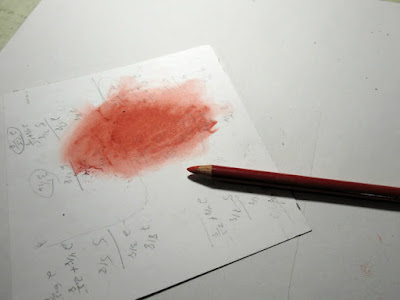Panoramic plate that will produce a printed image that measures 14 x 55 cm (5.5 x 21.5 inches.)
The plate has been sealed with several layers of clear shellac and now awaits the application of ink, wiping back and passing through the press.
It has been several months since my last post. I was away from home base for nearly an entire month. A few weeks back I was inspired to return to my studio and pursue an idea from several years back which was to create a collagraph print in large scale.
To date the biggest collagraph from the studio has been (13 x 18 cm) or 5 x 7 inches.
I used a photo I had taken during a visit to the town of Marathon that is located along a section of the rugged shoreline of Lake Superior here in northwestern Ontario. I had spent 8 years of my life living here as a youngster. This region has some of the most dramatic terrain in Canada aside from the coasts that border all coasts of the country. It is also an area where a few members of Canada's famous group of seven artist collective journeyed farther north along Lake Superior from the Algoma region to paint depictions of this region and it's interior coastal areas. These included Lawren Harris, A.Y. Jackson and Frank Johnson.
Harbour in Marathon ON, Carden Cove to the right
 |
Lawren Harris,
Afternoon Sun, North Shore Lake Superior
oil, 1924
|
 |
Lawren Harris
Coldwell Bay, North of Lake Superior
oil, 1923
|
 |
Shoreline
A.Y. Jackson
oil
year unknown
|
 |
A.Y. Jackson
Entrance to Pucasaw Bay
oil, 1930
Collection of Art Gallery of Algoma
|
My decision was to create a horizontal panoramic print constructed using a variety of media on a heavy paper-board surface. I happened to have a large rectangular frame (blond birch) in storage and this also helped to determine what the actual print image size would be.
pencil sketch on hot press smooth surface paper board
materials and tools I used to create the plate included: liquid mediums including glue, acrylic gels and pastes. Also dried plant bits and cut paper.
After the sketch was finalized on the board I went over the pencil with a fine point waterproof marker. Then I chose an area to begin cutting. My plan would utilize both subtractive and additive treatments to the surface. Subtractive (removing top layer) would yield a recessed area that would contain rougher surface enabling ink to collect and produce darker definition to that specific element of the image when the plate is printed.
I brushed on a thin coat of water diluted acrylic glaze over the board surface and let it dry. This would help to make sure when I cut and removed areas through a subtractive process that the paper edges would remove cleanly without too much tearing occurring.
Using a surgical scalpel I cut a shallow line around one of the foreground islands. I then carefully gripped a corner of the cut area and peeled away the paper surface. These peeled areas in the background hills would be defined by a bit darker ink during the printing process.
However for the hills and islands in front of these I wanted to have a bit more textural definition to show foliage.
For the distant islands and hills more to the front I created texture by using a sharp homemade etching needle where I scored into the exposed layer of paper board in small strokes to work up little linear elements that would recreate small coniferous trees (viewed from a distance.)
To help me see how the textural effect of roughing up the paper board was coming along with my finger I gently wiped a little powder from a dark red colour conte over the area.
for the mid range hill terrain I stippled the board surface with the point of a proper etching needle. The needle tip created tiny pock marks that would hold ink and would differentiate scale of trees in a slightly smaller size compared to the island in front of it.
The next stage was to create an interesting sky. I really wasn't fond of the heavily clouded sky in the reference photo. Drawing on memory I decided to add in just a few fluffy cloud tops emerging from behind the distant hills plus a few traces of whispy cloud formation higher up. To create the fluffy clouds I used small bristle brush and acrylic gel medium. For the wispy clouds I used modelling paste and wiped it on with a finger tip.
I wiped a little dry powder from conte stick to reveal the texture of the clouds in the sky
|
The last area to focus on was foreground foliage. I decided a few select trees would be created by cutting into the board surface and peeling away surface layer. Some would be emerge from a collage of both dried plant materials, cut out paper shapes that could be glued on and finally some would be derived from addition of textural medium onto the board surface.
removal of the white smooth surface reveals rougher textured layer below. I then added in small areas of liquid acrylic medium to create small raised areas that will hopefully add a little pos/neg space effect in the trees.
using the smallest pair of scissors I cut out tiny little leaves from thin cereal box packaging for one of the foreground trees. These were glued onto the board surface.
I had a small box of dried plant fibers I had collected during walks. Some of these were adhered to the board with liquid acrylic gel to bond it to the board surface. I pressed down on the bits with a piece of plastic and held it for a minute to allow the adhesive to take hold.
In my next post I will be inking the plate and pulling my first working proof from it.





















































